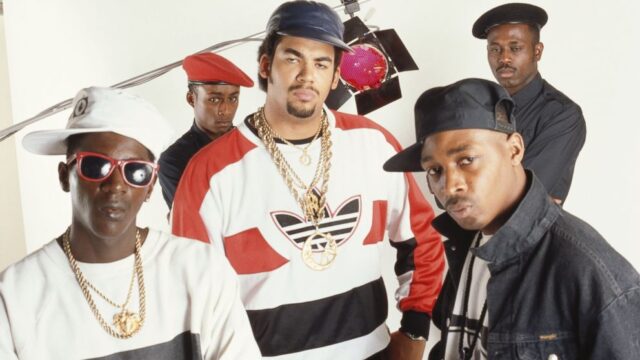Professor Griff, Public Enemy, and the Precarious Black–Jewish Partnership
When Kanye West, more popularly known as “Ye,” recently released a song titled “Heil Hitler,” it was not the first time a hip-hop artist’s rhetoric strained Black-Jewish relations. In 1989, Professor Griff of Public Enemy made antisemitic claims in an interview that set off a media firestorm and reopened deep, historical tensions between the two communities.
Born in 1960, Richard Duane Griffin, known as Professor Griff, rose to prominence as a key member of Public Enemy, one of the most influential rap groups of all time. As the group’s self-proclaimed “Minister of Information,” he fused a commanding stage presence with pointed political commentary, helping to make Public Enemy both critically acclaimed and socially disruptive.
Griff’s role extended far beyond lyrical contributions. He developed the group’s stage routines, managed its armed-guard “Security of the First World” (S1W) dance unit, and infused its message with Afrocentric themes. Public Enemy’s sound and style were unapologetically abrasive and confrontational, quickly becoming the soundtrack for a generation of Black political protest. Albums like Yo! Bum Rush the Show (1987), It Takes a Nation of Millions to Hold Us Back (1988), and Fear of a Black Planet (1990) revolutionized hip-hop’s sound and challenged its audience to think politically. Songs such as “Fight the Power” became early hip-hop anthems, embedding Public Enemy’s defiant style into the very fabric of the genre.
While Griff was less visible than frontmen Chuck D and Flavor Flav, his creative input was indispensable. His spoken-word interludes, authoritative stage presence, and conceptual vision for S1W gave Public Enemy one of the most distinctive performance identities in the hip-hop genre. But as the group’s influence grew, Griff’s offstage rhetoric would spark one of hip-hop’s most damaging controversies.
The fallout began on May 22, 1989, during an interview with The Washington Times reporter David Mills. Griff asserted that “Jews are responsible for the majority of the wickedness in the world” and claimed he could “prove” their wickedness. He accused Jews of controlling American institutions, pointed to their dominance in the jewelry business, and went so far as to say that “if the Palestinians took up arms, went into Israel and killed all the Jews, it’d be all right.”
These remarks did not appear in a vacuum. Griff’s views were heavily shaped by the Nation of Islam’s ideology, particularly the teachings of Louis Farrakhan, and by material circulated by the NOI’s historical research department. He drew directly from The Secret Relationship Between Blacks and Jews, which argued that Jews dominated the Atlantic slave trade, and from Henry Ford’s The International Jew.
The backlash was immediate. Jewish organizations, mainstream media outlets, and music critics condemned his remarks. Public Enemy’s once-radical posture was now a liability. Chuck D initially tried to defend Griff but eventually relented to mounting pressure. On June 19, 1989, he announced Griff’s removal as Minister of Information for failing to represent Public Enemy’s program. Less than two weeks later, under unrelenting public and industry scrutiny, Chuck D announced the group’s temporary disbandment.
By August of that year, Public Enemy had reformed and reinstated Griff in a reduced role as “Supreme Allied Chief of Community Relations,” but the arrangement was short-lived. The mounting public pressure on the group proved overwhelming. The Anti-Defamation League of B’nai B’rith lodged protests with CBS/Columbia Records, which distributed Public Enemy’s albums.
Walter Yetnikoff, head of CBS, sent a memo to his executives urging them to “pay more attention to what their acts were saying with regard to matters of ethnicity.” Jewish leaders across the country condemned Griff’s remarks, the national media erupted, and even longtime allies distanced themselves. Russell Simmons, co-founder of Public Enemy’s label, reportedly dismissed Griff as “a racist stage prop.” By the end of 1989, Griff was permanently kicked out of Public Enemy.
Despite the damage to his reputation, Griff re-emerged in later years, continuing to champion Black empowerment while rarely retracting his earlier views. In June 2020, he appeared on Nick Cannon’s “Cannon’s Class” podcast, where both men engaged in a discussion about Jewish power and Semitic identity. Cannon endorsed Griff’s claims concerning Jewish power, calling him a “legend” and proclaiming, “you’re speaking facts.” Cannon’s conversation triggered the predictable backlash from the usual suspects, with groups like the ADL, the Simon Wiesenthal Center, the American Jewish Committee, and regional Jewish federations denouncing his remarks, ultimately pressuring ViacomCBS to cut ties with him.
In 2025, Griff remains active through lectures, interviews, and social media, appearing on programs such as “The Carl Nelson Show” to discuss Black music and history. While his recent rhetoric has been less inflammatory than in 1989 or 2020, his continued association with controversial ideas keeps him relevant in debates about antisemitism in hip-hop.
The fallout from Griff’s remarks cannot be understood without examining the broader history of Black-Jewish relations in America. Historically, these communities forged important alliances, particularly during the Civil Rights movement, when Jewish leaders and organizations lent significant support to Black activists. Yet beneath the surface, the relationship has always been precarious.
As this author has previously mentioned, Black-Jewish relations in modern America have been marked by repeated clashes despite earlier civil rights solidarity. From the 1968 Ocean Hill–Brownsville school crisis to the 1991 Crown Heights riots, from the Nation of Islam’s rhetoric on Jewish influence to high-profile disputes over Israel and Palestine involving figures like Tamika Mallory, Marc Lamont Hill, and Black Lives Matter, these episodes have exposed deep and persistent fault lines in this presumed alliance.
At some point, as political priorities realign, Black Americans may find themselves overlooked while other potential golems—Indian migrants in particular—are cultivated to serve the agendas of those in power. As new minority groups rise to prominence, Professor Griff’s legacy stands as proof that the Black-Jewish alliance has always been tenuous, and its future may lie in obsolescence rather than renewal.

